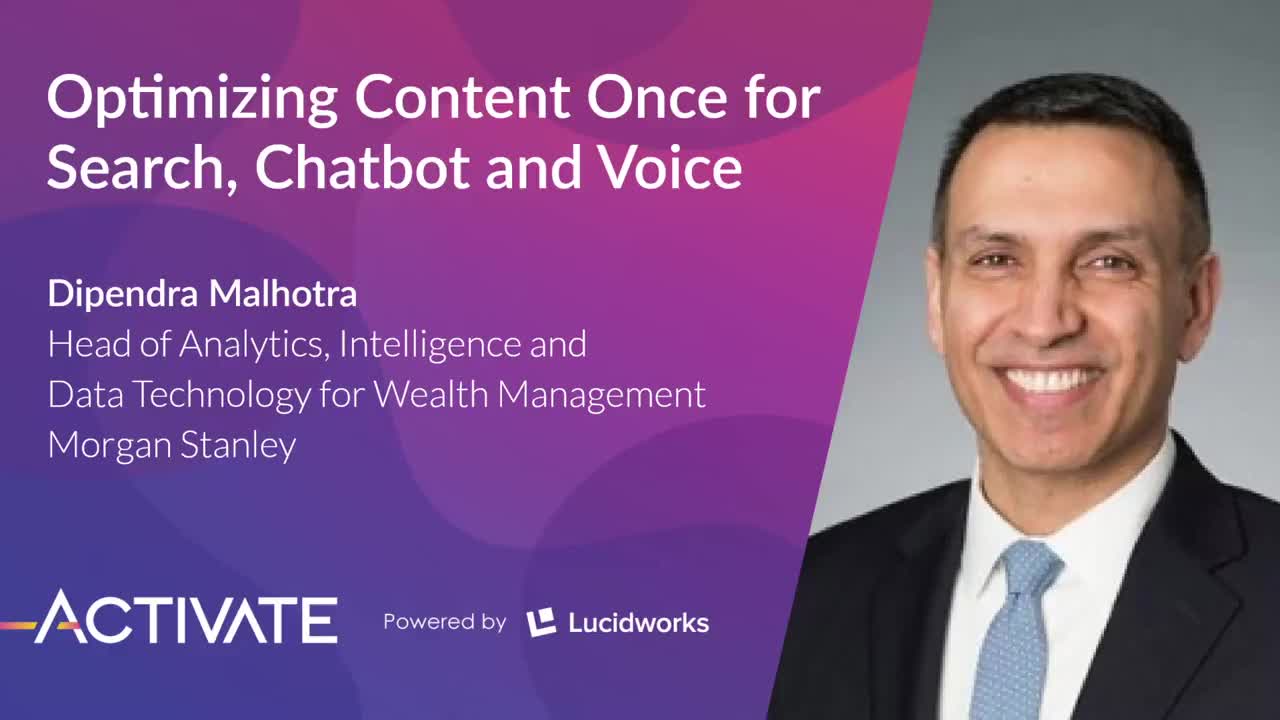3M
clients
15K
financial advisors
1
knowledge base
How one of the world’s leading financial institutions uses AI to serve consistent information across multiple channels to 15,000 financial advisors managing $2.6 trillion in assets.
“It became very important for us to focus on the content once, because that’s where the human capital is utilized. Where that content is rendered really doesn’t matter because all those channels can be automated.”
—-Dipendra Malhotra, Head of Analytics, Intelligence, and Data Technologies, Morgan Stanley
The knowledge multiplication challenge
A company’s most valuable resource lies in its employees. That’s what Morgan Stanley’s Head of Analytics, Intelligence, and Data Technologies, Dipendra Malhotra, recognized when tackling a common enterprise challenge: How to make specialized knowledge consistently available across multiple channels without duplicating work.
With 15,000 financial advisors managing $2.6 trillion in assets and serving 3 million clients, Morgan Stanley faced a significant knowledge management challenge. The firm offers a broad range of services—financial planning, advisory services, transactional support, cash management, and lending—each generating its own knowledge corpus that needs to be accessible to diverse users.
The content creation bottleneck
Traditionally, when subject matter experts (SMEs) created content, it needed to be recreated, reformatted, and customized for each delivery channel:
- Search results required one format
- FAQs needed another structure
- Chatbots demanded conversational phrasing
- Voice interfaces required yet another approach
This meant the same information was being recreated multiple times by highly skilled professionals. Even adding synonyms and business rules to optimize content for one channel didn’t help with others. The process was inefficient, expensive, and often resulted in inconsistent information across channels.
“The most expensive item in this whole chart is the content field at the bottom,” Malhotra explained, “because that’s where you have your SMEs creating that content, thinking about the questions, thinking about the answers, thinking about the search, thinking about what needs to be rendered on the search. Everything else can be done very quickly and through the machine.”
The single source of truth approach
Morgan Stanley realized the solution wasn’t to hire more content creators or build bigger teams—it was to fundamentally change how content was managed and delivered. Malhotra’s team developed a strategy centered around a simple but powerful principle: create content once, then use machine learning to customize responses for different channels.
They built a system using a comprehensive ontology to house their knowledgebase and leveraged the indexing and machine learning capabilities of Lucidworks Fusion to power the delivery.
The new workflow was elegantly streamlined:
- SMEs create content once and add synonyms, tags, and hierarchy rules
- All content is loaded into Fusion for indexing
- Machine learning takes over, rendering the content appropriately for each channel
Intelligent content delivery in action
Malhotra illustrated this approach with a common customer query: “I want to open an account” or “how to get an account.”
In the new system:
- The intent (“open”) and entity (“account”) are automatically identified
- The system determines who is asking: a financial advisor, a client, or a service agent
- Context is established based on similar users’ behavior or the specific user’s past actions
- The channel being used is identified
- Fusion delivers relevant results customized to that specific user and channel
To further refine results, the system can intelligently extract more details. For example, if a customer is using a chatbot to open an account, the system might prompt: “What kind of account do you want to open?” If the customer responds “IRA,” then query results will specifically explain how to open an IRA account.
Measurable business impact
By implementing this intelligent content management approach, Morgan Stanley achieved several significant business outcomes:
- Reduced content creation redundancy: SMEs only need to create information once instead of customizing it for multiple channels
- Improved information consistency: All channels draw from the same knowledge source, eliminating conflicting information
- Enhanced user experience: Customers and employees receive appropriate responses formatted for their channel of choice
- Substantial time savings: High-value employees focus on creating quality content rather than reformatting existing information
- Scalable knowledge management: The system can easily expand to accommodate new channels or information types
The future of enterprise knowledge
For Morgan Stanley, this transformation represents more than just an efficiency improvement—it’s a strategic advantage in an industry where timely, accurate information is essential to serving clients effectively.
With 3 million clients and $2.6 trillion in managed assets, even small improvements in how their 15,000 financial advisors access and deliver information can translate into significant competitive advantages and cost savings.
Most importantly, this approach recognizes the true value of human expertise. By using machine learning to handle the mechanical aspects of content delivery, Morgan Stanley has freed its subject matter experts to focus on what they do best: creating high-value content that helps serve clients more effectively.
By creating content once and using AI to deliver it appropriately across multiple channels, Morgan Stanley has transformed how its 15,000 financial advisors access and share information while serving 3 million clients with $2.6 trillion in managed assets—proving that in financial services, intelligent knowledge management isn’t just an operational improvement, it’s a competitive advantage.
